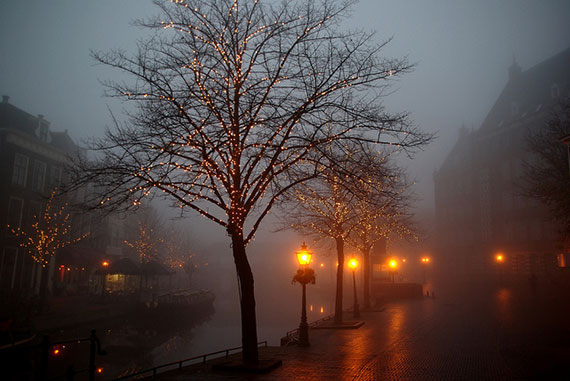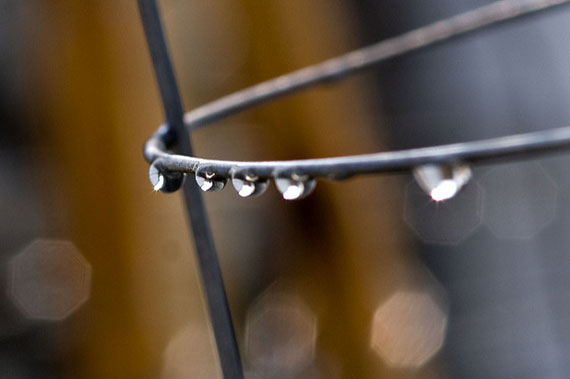Soon we will be considering photography tips on waves, waterscapes, waterfalls, reflections, abstracts, splash ‘n spray, foam, bubbles, and puddles as remedies for the photo doldrums. But, water can provide even more photo ops! Regularly check your local weather forecasts and keep a notebook of the special places you find in your neighborhood that provide good locations for shots that include the following:

Photo by Karsten Wentink; ISO 200, f/8.5, 1/8-second exposure.
1. Mist
In the early morning or late evening, mist or groundfog can generate “artist’s light” as masses of water vapor condense from coolness near ponds, rivers, etc. or down in ravines and valleys. It burns off quickly though, so you have to anticipate it and get there early. Look for things extending above the mist—or visible through openings in it—as it swirls about.
2. Fog
Fog can make all the difference between ordinary and exceptional images. In foggy scenes, include foreground objects for silhouettes and interesting contrasts. Just remember that you generally have to increase your exposure by 1/2 to 3/4 of a stop to avoid a picture that’s too dark.
3. Condensation
Perhaps more often associated with man-made things—cold objects amid warm, moist air—condensation is an often overlooked source of interesting pictures. Watch out for cold water pipes and surfaces in warm places. Or, open your fridge and check out the food containers with clear plastic lids. Are there any condensed water droplets on the underside of the lids? Remove the lid without disturbing the droplets, (Tip: Leave the lids just sitting on top instead of clicked down tight) and gently place it down on a flat surface suitable for a background. Set up your camera to shoot straight down on the lid for over-all sharpness.
4. Hail
Hail is possible with most thunderstorms as it is usually produced at the leading edge of a severe storm system and usually falls within two miles of its parent storm, during the summer months, in the afternoon and evening hours. Hail-producing clouds are often identifiable by their green coloration and hailstorms normally last about 3-15 minutes. Hailstones can vary from less than pea-size to larger than four inches. Place a hailstone over a slightly smaller hole in black cardboard and shine a light up through the hole and the hailstone, and photograph the hailstone’s interior structure. Or picture assorted stones along with coins, etc. for size comparison on a dark background. Or photograph it after a heavy fall where ever it lays, amid the damage it may cause.

“Hail & Rain” captured by Kurt Bauschardt
Self-Assignments
Choose the projects that interest you most. Follow the photography tips conscientiously. Re-shoot when you aren’t satisfied. Do it until you are satisfied. It’ll take all your patience and passion. Your skills and eye will improve with the practice. Shoot especially in early and late light. Use a tripod as much as possible. Edit your results relentlessly. Pin small samples on the wall for a few days to study before making final prints for wall art.
Mist: When the weather forecast predicts ground fog, have a rural scenic spot in mind to go to that has higher and lower sections within it and shoot it just as the sun comes up.
Fog: When the weather forecast predicts fog, have a scenic spot in mind to go to and shoot a portion of it that has things that recede from you into the fog, with some leaves hanging down into the top of the frame as silhouettes.
Condensation: If you have a container of yogurt with a clear plastic lid in your fridge, just sit the lid on top of the container and don’t click it down tight. When water drops from condensation form a pattern of circles on the underside of the lid, gently take the lid and place it down on a table or counter top, without disturbing the drops. Shoot straight down on it and make a close-up of a part of the pattern.

Photo by PhotoJeff; ISO 100, f/8.0, 1/125-second exposure.
Hail: When a thunderstorm is in the forecast, keep an eye out for hail. Find a safe place to shoot from and shoot the hail as it falls and bounces off of things, using both fast and slow shutter speeds.
In the next article of this set we’ll consider photography tips about water’s cold season photo ops to remedy the photo doldrums.
About the Author:
John Maxymuik from AmbienceImages authored this article which is 1 of a set of 6 on Photography Tips for the Photo Doldrums providing tips to break the grip of the photo doldrums using the “ideal photo subject”. Maxymuik previously operated a website at ambienceimages.
Go to full article: Photography Tips for Mist, Fog, Condensation, and Hail
What are your thoughts on this article? Join the discussion on Facebook
PictureCorrect subscribers can also learn more today with our #1 bestseller: The Photography Tutorial eBook
The post Photography Tips for Mist, Fog, Condensation, and Hail appeared first on PictureCorrect.
from PictureCorrect https://ift.tt/3iedX9H
via IFTTT






0 kommenttia:
Lähetä kommentti